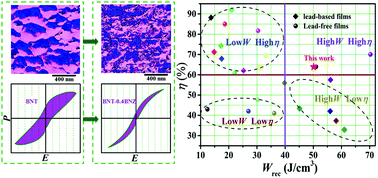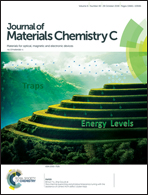Giant energy-storage density and high efficiency achieved in (Bi0.5Na0.5)TiO3–Bi(Ni0.5Zr0.5)O3 thick films with polar nanoregions†
Abstract
The development of electronic devices towards integration, miniaturization and environmental friendliness has propelled much recent research on lead-free dielectric capacitors for energy storage, however, high energy-storage density is still an extremely challenging objective for lead-free dielectric materials. Here, a novel lead-free relaxor ferroelectric (1 − x)(Bi0.5 Na0.5)TiO3–xBi(Ni0.5Zr0.5)O3 (BNT–xBNZ, x = 0–0.5) thick film (1 μm) was fabricated by a water-based sol–gel method. Doping of BNZ into the BNT host promoted the formation of polar nanoregions (PNRs), whose domain switching became easier, leading to an improved energy-storage performance. Surprisingly, an ultrahigh recoverable energy density of 50.1 J cm−3 and a high energy-storage efficiency of 63.9% under 2200 kV cm−1 were achieved simultaneously with x = 0.4, which are both more than 100% higher than those of the pure BNT sample. This excellent energy-storage performance can be perfectly comparable with that of lead-based films. Furthermore, the BNT–0.4BNZ thick film showed strong fatigue endurance after 6 × 107 cycles, and it possessed good thermal and frequency stability. The pulsed discharge current waveform demonstrated that the BNT–0.4BNZ thick film showed a very fast discharge speed (210 ns). This study shows that BNT-based materials have an unexpected role as a lead-free family in the field of energy storage and could stimulate the design and fabrication of BNT-based dielectrics with ultrahigh energy-storage performance.



 Please wait while we load your content...
Please wait while we load your content...